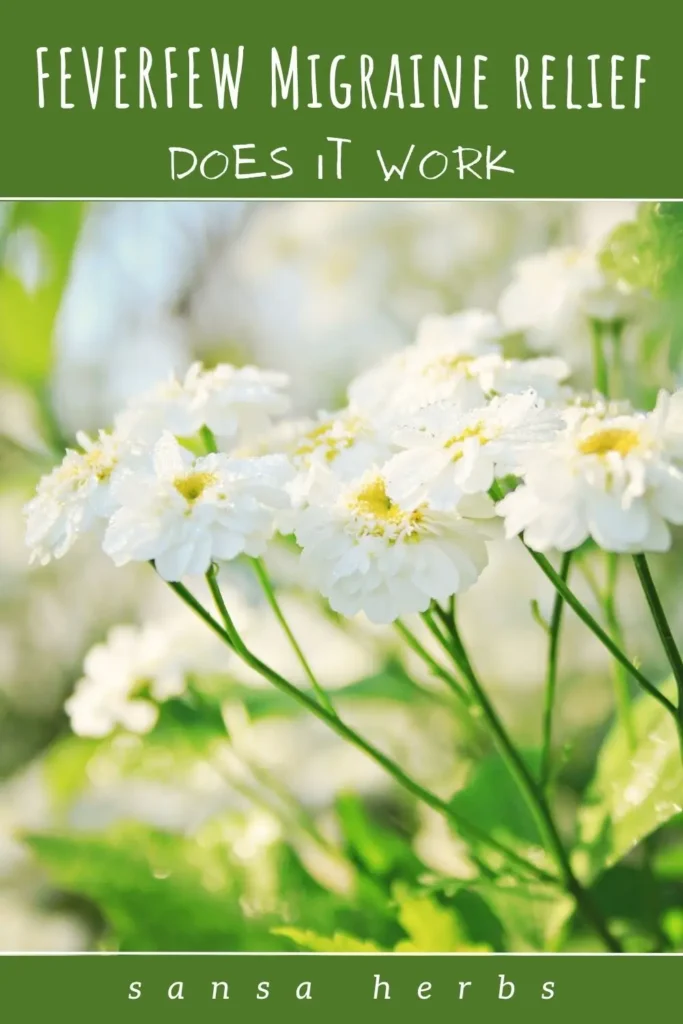Migraines can be tough. Many people look for natural ways to find relief, and one plant often mentioned is feverfew. But does it really work? Let’s explore what we know about using feverfew for migraines.

What Is Feverfew?
Feverfew is a plant with small, daisy-like flowers and feathery leaves. You might also hear it called featherfew or bachelor’s buttons. Its official botanical name is Tanacetum parthenium, though it was once classified under Chrysanthemum parthenium.
Originally from parts of Asia and the Balkans in Europe, feverfew now grows worldwide, often in gardens or along roadsides.
Interested in growing your own supply? Learn how in our guide to growing feverfew from seed.
A Long History of Use
The name “feverfew” comes from the Latin words meaning “fever reducer.” Ancient Greek doctors used it for inflammation, and traditional medicine employed it for:
- Fevers
- Headaches
- Arthritis pain
- Stomach aches
- Menstrual problems
This historical link to headaches and inflammation likely sparked modern interest in feverfew for migraines, which may involve brain inflammation. The wide range of traditional uses suggests the plant contains multiple active compounds that affect the body in complex ways.
How Might Feverfew Help Migraines?

Scientists are still studying how feverfew works, but it appears to influence migraines through several pathways. The key compound is parthenolide, a sesquiterpene lactone found mostly in the leaves. Here’s how feverfew might help:
- Fighting Inflammation: Migraines may involve inflammation, and feverfew has anti-inflammatory effects. It may reduce prostaglandins (linked to pain) and block inflammatory signals like the NF-κB pathway.
- Calming Blood Vessels: Feverfew might prevent blood vessels in the head from spasming, which plays a role in migraines.
- Balancing Serotonin: Changes in serotonin levels can trigger migraines. Feverfew may help regulate serotonin release.
- Affecting Platelets: It might reduce platelet stickiness, which could influence blood flow during migraines.
- Blocking Pain Signals: Parthenolide may interact with nerve channels (TRPA1) involved in pain, potentially blocking the release of CGRP, a molecule targeted by some prescription migraine drugs.
Feverfew also contains other beneficial compounds, like flavonoids (e.g., tanetin), which may contribute to its effects. Because multiple components could be at play, the type of product used (whole leaves vs. extracts) might impact results.
Does Feverfew Actually Work for Migraine Prevention?
The evidence is mixed. Some older or smaller studies suggest feverfew may reduce migraine frequency and severity, including symptoms like nausea and light sensitivity. However, major reviews (like those from the Cochrane Collaboration) are more cautious.
A 2015 Cochrane review analyzed six trials and found that one well-designed study using a specific feverfew extract (MIG-99) showed a small benefit, about 0.6 fewer migraines per month compared to a placebo. However, the overall evidence was deemed low quality, and other rigorous studies found no difference between feverfew and placebo.
Why the Mixed Results?
- Different feverfew products were used, with varying levels of active compounds.
- Doses varied across studies.
- Feverfew is studied for prevention, not acute migraine relief, it works gradually, not instantly.
Some research combines feverfew with other supplements (like magnesium or riboflavin), making it hard to isolate its effects.
My Herbal Headache Blend:
When I feel a headache coming on, I sip a homemade tea of lemon balm, feverfew, and mint. It masks the bitterness of feverfew and helps me relax.
Using Feverfew: Forms, Dosage, and Considerations
If you’re considering feverfew for migraines, here’s what to know:
Forms Available:
- Dried leaf capsules/tablets (most common in studies)
- Freeze-dried capsules
- Liquid extracts (tinctures)
- Fresh leaves (can cause mouth sores)
- Tea (bitter taste; potency uncertain)
Dosage for Prevention:
There’s no official dose, but studies often use 50–150 mg of dried leaf powder daily. Some sources suggest up to 300 mg/day.
For specific extracts (like MIG-99), 6.25 mg three times daily was used. Chewing 2–3 fresh leaves daily is a traditional method but often causes mouth irritation.
Key Tips:
- Standardization matters: Look for products with 0.2–0.4% parthenolide, but be aware that actual content can vary.
- Consistency is key: Take it daily for prevention.
- Patience required: It may take 4–6 months to see if it helps.
How to Make Feverfew Tea (Fresh or Dried)
Fresh leaves: Use 2 to 3 small fresh leaves per cup. Lightly chop or bruise, steep in hot (not boiling) water for 5 to 7 minutes. Strain before drinking.
Dried leaves: Use 1 teaspoon of dried leaves per cup. Steep for 5 to 10 minutes in hot water, then strain.
Tip: Feverfew is very bitter on its own. Blend with herbs like lemon balm, peppermint, chamomile, ginger, or lemongrass to improve taste and add calming benefits.

How Often Should You Drink Feverfew Tea?
Feverfew works best when taken daily as a preventive remedy. Most herbalists recommend:
- One cup daily for 4 to 6 weeks
- Take a 1 to 2-week break between cycles
- Reduce to 2 to 3 times per week as a maintenance dose
Do not use continuously for months without breaks and monitor for side effects like mouth irritation or stomach upset.
Is Feverfew Safe? Side Effects and Warnings
Feverfew is generally safe for short-term use (up to 4 months) but has potential side effects and important warnings.
Common Side Effects:
- Mouth sores, irritation, or loss of taste (especially from fresh leaves)
- Digestive issues: Nausea, bloating, diarrhea
Who Should Avoid Feverfew?
- Pregnant women (may cause uterine contractions)
- Breastfeeding women (safety unknown)
- People allergic to ragweed, daisies, or chrysanthemums (Asteraceae family)
- Children under 2 (consult a doctor for older kids)
Bleeding Risk & Drug Interactions:
- May slow blood clotting, avoid before surgery or if taking blood thinners (warfarin, aspirin).
- Can interact with liver-processed drugs (e.g., some antidepressants, statins).
- May affect NSAIDs (ibuprofen) or other migraine medications.
Withdrawal Symptoms:
Stopping suddenly after long-term use may cause “post-feverfew syndrome” rebound headaches, anxiety, or muscle stiffness. Taper off slowly if needed.
🌿 Frequently Asked Questions
Can I drink feverfew tea every day?
Yes, but it’s best to use it in cycles, drink daily for 4 to 6 weeks, then take a short break to avoid overuse or irritation.
What herbs taste good with feverfew?
Blend with peppermint, lemon balm, chamomile, ginger, or lemongrass to reduce bitterness and boost the calming effects.
Does feverfew work right away for migraines?
No, it’s a preventive herb. Benefits typically build over time with consistent use, sometimes taking several weeks or months.
Are there any side effects?
Fresh leaves can cause mouth sores. Other possible side effects include bloating, nausea, or allergic reactions in sensitive individuals.
The Bottom Line: Should You Try Feverfew For Migraines?
Key Takeaways:
- Feverfew has a long history of use for headaches, but scientific evidence is inconclusive.
- It may work through anti-inflammatory, blood vessel, and nerve-signaling effects.
- Best studied for prevention (not acute relief).
- Quality and dosage vary, look for standardized extracts.
- Potential side effects and interactions exist, especially for pregnant women, allergy sufferers, and those on medications.
Most Important Step: Talk to Your Doctor!
Before trying feverfew:
- Check for drug interactions (especially blood thinners or liver-metabolized meds).
- Discuss your health history (allergies, bleeding risks).
- Confirm your headaches are migraines and not another condition.
“Natural” doesn’t always mean “safe.” Feverfew has real effects on the body, so professional guidance is crucial.
Final Thoughts
Feverfew remains an intriguing natural option for migraine prevention, but its benefits are uncertain, and risks exist. If you decide to try it, do so under medical supervision, and be patient, it may take months to see any effect.
Have you tried feverfew for migraines? Share your experience in the comments!
